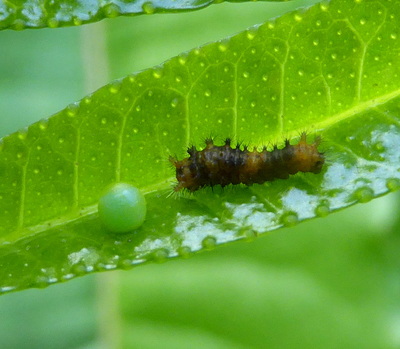|
Today we drove out along the Ancon Valley road for a few miles and then drove up the hill through the forest. When near the top we jumped out and starting walking down leaving Duviel to follow in the vehicle periodically. Almost immediately we found a female Androgeus Swallowtail Heraclides androgeus laying on the young shoots of some bushes growing beside the road. Unfortunately as the light was still not very good for in-flight photography and all my shots were very poor so here is one I took on earlier trip. We soon noticed that these bushes were covered in eggs and larvae of different sizes. Rayner's sharp eyes soon spotted a possible Confusing Yellow Pyrisitia larae in the grass. I took some pictures and then netted it to be sure. These things are always confusing until you learn the differences but the reduced black on the forewing and fewer spots on the underside hindwing distinguishes it from Little Yellow P. lisa. The difference from Mimosa Yellow P. nise is more subtle as the background colour and amount of black on the forewing is very similar. Male nise however have a black border on the hindwing (which larae lacks), and female nise have more spotting on the underside. Both sexes of larae look the same and are paler, especially on the upperwing than Bush Sulphur P. dina. These are the first pictures of P. larae that I can find on the internet. It is endemic to the West Indies found only on Cuba, Hispaniola and the Bahamas. We had seen Cuban Kite Swallowtail Eurytides celadon on three of the previous four days but only briefly as they can fly quite fast and rarely seem to stop. They are also quite small for a Swallowtail but suddenly two appeared next us nectaring on Stachytarphetum - not easy to photograph as they spend very little time at each flower. In the Butterflies of the West Indies Indies and South Florida the plates, done by Richard Lewington show celadon with the blue appearing as off-white. This is because set specimens (from which I believe RL did his paintings) quickly lose their blue colouration. As we headed down the hill we also saw Gray Ministreak Ministrymon azia the smallest of the hairstreaks and easily overlooked for one of the blues in flight. We spent some time taking pictures of the yellows and sulphurs taking moisture on the road. There were many Bush Sulphur Pyrisitia dina, three Apricot Sulphur Phoebis argante. and at least one Confusing Yellow P. larae Note the narrow black edge on the forewing of P. dina (on the left) with the tinge of orange on the hindwing that is often visible in flight at close range. All in all an excellent day today with lots of good finds including this Dorantes Longtail Urbanus dorantes larva.
0 Comments
Leave a Reply. |
Welcome to our Blog
Here we will post interesting news about what we and others have seen in Cuba. Archives
July 2024
Categories |












 RSS Feed
RSS Feed